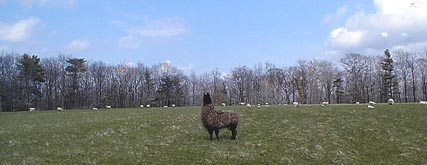Mount
Saviour Monastery

The new center of attraction on the farm, a llama
News:
Through the media,
we
were able to follow the events related
to the death of John Paul II. The TV
coverage allowed some of us to join the thousands of faithful in prayer
and
awe. The remarkable crowd of political
figures gave us the scope of one man’s influence on society. Our friend and oblate, Dr. Anthony Cernera
had the privilege to attend the funeral service and gave us his
comments below.
Special Retreats:
For some time now, we have not been
scheduling
Retreats
except for some groups that requested them.
However we realize that people can use some input of prayer,
spirituality, scripture or theology.
Being able to join with us in prayer in the Chapel and the
atmosphere of
the monastery help to deepen the experience of the conferences. The Meaning of Advent was the topic in
December; the Passion of Christ in March; Mary Our Mother the last of
April and
20-21-22 May will be The Eucharist in Our Lives; finally 24-25-26 June,
the
Universal Love of Christ. People are
able to come for the days and not stay over at the monastery. Please
call
Br.James Cronen 607 734 1688 or e-mail smjssmn@aol.com
for
Coming
Events:
The Third Damasus Winzen
Memorial
Lecture will be given at 4pm on Sunday, June 12th, by Nathan
Mitchell.
Click here for more
details and events.
Mount Saviour page
Guest Brother E-mail: guest@msaviour.org
Monastery E-mail: info@msaviour.org
Gospel of the Day
A Papal Legacy: Do Not Be
Afraid - Reflections
of an Oblate of Mount Saviour
By
Dr. Anthony J. Cernera
From
any direction that one looked, there were people, tens and hundreds of
thousands of them. They were young and old, rich and poor, the famous
and those
known only to their families and friends. Heads of state and ordinary
citizens
were there, united, to celebrate a great life lived. And of course the
young
people, who chanted many times today their profound love for him.
I
was privileged to be among them at the wake and funeral of Pope John
Paul II,
representing both Sacred Heart University's Center for Christian-Jewish
Understanding – a center he inspired – and the International Federation
of
Catholic Universities. Even more astounding, I was seated within 100
feet of
the mortal remains of the Pope. There I was, a Catholic, standing in
the midst
of 25 Jewish brothers and sisters, praying for the leader of my church.
Not
only were the leaders of the Catholic Church there but seemingly those
of every
major religion and nation. Why? Why such a public outpouring at the
passing of
the Bishop of Rome? Hadn't the most recent guru of things Catholic, Dan
Brown,
in his novel Angels and Demons painted a picture of the death of the
Pope as
being one in which no one in the world seemed interested? Why were so
many
people coming to pay their respects?
In
one sense, it was obvious. Many had come to honor the man who for 26
years was
the leader of the Catholic Church and its visible sign of unity. But it
was
more than that. These people had come here to the Vatican to remember
and
celebrate a person who reminded all of us of what is best in us as
human
beings. He had given us a legacy of hope and of human possibility even
in the
face of the fears, anxieties and sufferings of human life.
John
Paul II embodied for countless millions the opening words of perhaps
the finest
document of the Second Vatican Council, Gaudium et Spes: "The joys and
the
hopes, the griefs and the anxieties of the men of this age, especially
those
who are poor or in any way afflicted, these are the joys and hopes, the
griefs
and anxieties of the followers of Christ." These are words they may
never
have heard before, but he made them real because of how he lived. He
constantly
kept inviting all human beings to discover and affirm the dignity and
value of
human life and the way of love as the best way to live life well. He
embodied courage,
joy and hope – all of them rooted in his profound faith in God and in
God's
radical and unconditional love for each one of us.
It
would have been understandable had Karol Wojtyla chosen otherwise. His
mother
died when he was 8, and his only brother, when he was 12. At 19 his
father
died, leaving him without any immediate family. The year his father
died, the
Nazis crushed Poland and began the systematic elimination of Polish
Jews, among
whom were his professors and friends. In the midst of all of this, he
chose to
study for the priesthood. Since the Nazis had deemed this illegal, he
studied
in an underground seminary.
After
his ordination, he found himself working as a priest and then a bishop
in a
Poland occupied by the Soviet Union. In spite of all of this, or maybe
because
of it, he embraced life fully with a joy and hope and grace that was
infectious
to the tens of millions whom he touched during his long life. In the
face of so
many challenges, he could have been driven to despair and locked
himself in a
prison of fear. Rather than do that, he offered a profoundly simple
message: Do
not be afraid.